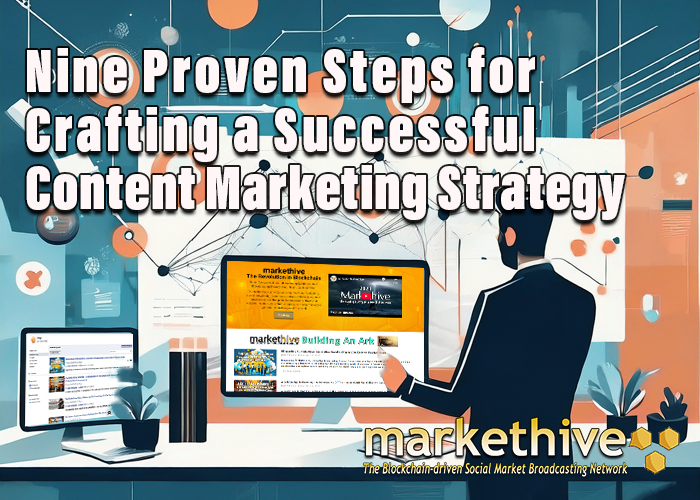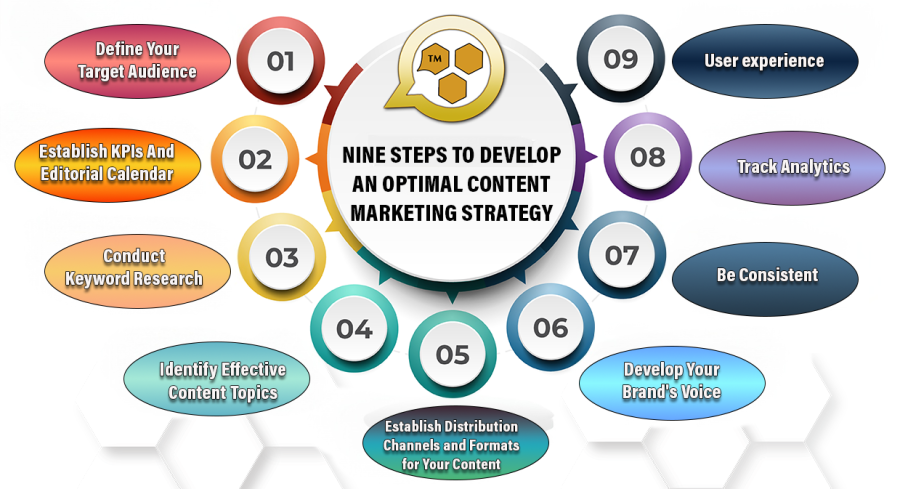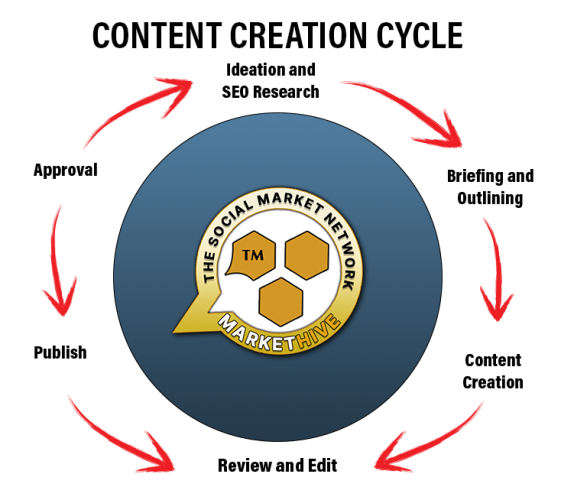

A robust content marketing strategy focuses on consistently creating and distributing high-value content tailored to a clearly defined target audience's specific needs, interests, and pain points. Its primary objective goes beyond immediate sales, encompassing the cultivation of enduring relationships with both potential and existing customers. This is achieved by providing genuinely helpful, informative, entertaining, and thought-provoking content, rather than relying on overtly promotional messaging.
The spectrum of content formats is broad and continually evolving, encompassing not only traditional text-based assets like in-depth articles, or blog posts that address specific industry challenges, frequently asked questions (FAQs) providing practical solutions, and white papers offering authoritative insights, but also increasingly popular visual and interactive mediums.
These include engaging video tutorials, informative webinars, visually appealing infographics, interactive quizzes and assessments, downloadable e-books and guides that provide comprehensive knowledge, case studies demonstrating real-world applications and successes, podcasts offering audio-based thought leadership and discussions, and even user-generated content campaigns that foster community engagement.
Effectively distributing this diverse content requires a strategic multi-channel approach. This involves leveraging channels directly owned and controlled by the company, such as Markethive, that integrates email marketing to nurture leads and keep audiences informed, the company's website and blog as central content hubs, and various social media platforms selected based on the target audience's online behavior to foster engagement and build community.
At the same time, an effective strategy utilizes external platforms to engage broader audiences and boost credibility. This could involve guest blogging on relevant industry sites, content syndication to expand reach, forming strategic alliances with influencers, and tapping into suitable online communities and forums. The Markethive Blogcasting feature transforms how content is shared and distributed across multiple channels, enhancing reach and visibility.
Furthermore, a successful content marketing strategy requires a clear understanding of business goals, including lead generation, brand awareness, customer acquisition, and customer loyalty. Content creation and distribution efforts should align directly with these objectives, incorporating measurable key performance indicators (KPIs) to track progress and improve performance over time.
This data-driven approach allows for continuous improvement of the content strategy to ensure maximum impact and return on investment. Ultimately, a well-executed content marketing strategy positions the company as a trusted authority and valuable resource in its industry, fostering strong customer relationships that drive long-term business growth and success.
Many marketers use the terms content strategy, content marketing, and copywriting interchangeably, which leads to confusion. However, while related, each term represents a distinct aspect of the content creation and dissemination process, with unique objectives and methodologies.
Content strategy lays the groundwork for any successful content endeavor. The overall plan dictates the what, why, who, when, and how of your content efforts. This crucial initial phase involves thorough research and careful planning to establish a clear direction and purpose for all subsequent content activities.
Content strategy serves as the blueprint, ensuring that all content marketing activities are purposeful, aligned, and contribute to the overall business strategy. Without a well-defined content strategy, content marketing efforts may become disjointed, ineffective, and fail to resonate with the target audience.
Conversely, content marketing focuses on the tangible creation, publication, and distribution of valuable and relevant content to attract and retain a clearly defined audience—and ultimately drive profitable customer action. It is the implementation phase where the strategic framework comes to life.
Content marketing encompasses various activities, including brainstorming content ideas, creating diverse content formats (such as blog posts, articles, videos, podcasts, ebooks, case studies, webinars, social media updates, and email newsletters), editing and proofreading the content for quality and accuracy, publishing it across selected platforms, and actively promoting it to engage the target audience.
While content strategy provides direction and content marketing executes the plan through creation and distribution, copywriting is a focused discipline centered on the art and science of crafting persuasive text for marketing and advertising purposes. Copywriters create compelling words to motivate specific actions from the reader, such as making a purchase, signing up for a newsletter, requesting a demo, or downloading a resource.
Copywriters often operate within the broader content strategy framework and significantly enhance the effectiveness of content marketing campaigns by crafting compelling calls to action and persuasive messaging within the content they create.
In summary, content strategy provides a strategic roadmap, content marketing encompasses the ongoing process of creating and distributing valuable content, and copywriting focuses on persuasive writing techniques used in marketing materials to drive specific actions. Recognizing and understanding these distinct roles and their interdependencies is crucial for developing and executing successful marketing initiatives.

A content marketing strategy should be integral to all content creation efforts. Although no strict rules exist for developing a content marketing strategy, incorporating these essential elements is crucial for any marketing plan.
A crucial initial step in crafting a successful content strategy is to define and comprehend your target audience. Identify your primary audience by creating detailed buyer personas that reflect their values and pain points. These buyer personas serve as fictional representations of your target audience, highlighting their purchasing behaviors, demographics, and objectives.
Each content piece your brand creates should target a specific audience. Prospective customers are more inclined to buy from a brand they resonate with. Therefore, effective content hinges on the brand's deep understanding of its audience. Quality content gets shared on social media and rises in search engine rankings.
Once you understand your target audience, the next step involves determining how to evaluate your content's effectiveness. This requires defining your key performance indicators (KPIs). These KPIs can include metrics such as sales figures, brand recognition, or search engine visibility. Additionally, it is essential to specify the methods you will use to measure the success of each piece of content you create.
To effectively measure the success of a blog, align metrics with its objectives. For instance, if the aim is to increase awareness, track website views and clicks rather than sales figures. Analyze the performance of different content formats, subjects, and calls to action to refine your strategy and create the most impactful content.
Effective planning is essential for a seamless content strategy, and using an editorial calendar can significantly reduce potential stress. This tool allows you to outline key content components such as topics, formats, publication dates, and assigned team members. This approach ensures your content is organized and aligned with your business goals. Furthermore, an editorial calendar fosters consistency, helps meet deadlines, and improves resource management.
To effectively reach your target audience online, begin by deeply understanding their needs and how they articulate them in their search queries. Imagine yourself as a potential customer actively seeking your specific product or service. What words or phrases would you type into a search engine?
With your keywords identified, you can begin digital marketing by incorporating them into your content. This offers several key benefits:
Below are popular SEO tools for keyword research:
|
|
|
|
|
|
|
|
|
|
|
|
|
|
|
|
|
|
|
|
|
|
|
|
|
Creating engaging content that connects with your target audience is a constantly evolving yet essential part of an effective content strategy. This involves brainstorming relevant topics for your ideal customers or buyer personas and producing written or visual materials based on those ideas.
Once these core concepts are established, the subsequent stage involves skillfully creating diverse written materials, such as insightful blog posts, informative articles, engaging white papers, compelling case studies, persuasive ebooks, and captivating social media updates.
Furthermore, the development extends to visually rich content, including striking infographics, informative videos, attention-grabbing presentations, high-quality photographs, and interactive visual elements. The key is to tailor the subject matter and chosen format to your target audience's preferences and consumption habits to ensure maximum impact and foster meaningful engagement.
To ensure long-term value, consistently maintain your content assets. For instance, update blog posts to keep them relevant and enhance SEO by incorporating internal links over time. By following a systematic content creation workflow, you can develop valuable content that effectively converts your audience into your customers.

Content distribution is a crucial element of content marketing. Identifying the best platforms for your brand requires testing various channels and understanding your target audience's content consumption habits. Email marketing remains a fundamental tool, enabling direct communication with subscribers and facilitating personalized messaging. Blogs are central hubs for in-depth content, establishing thought leadership and driving organic traffic through search engines. Both channels continue to be top strategies employed by B2B companies.
Professional networking platforms like LinkedIn are designed to reach B2B audiences and foster industry connections. Social media platforms, including Facebook, Instagram, and X, provide diverse formats for engaging with broader audiences, building brand awareness, and nurturing community. Both B2B and B2C heavily utilize these channels. Newer platforms and emerging trends should be consistently evaluated for their potential reach and relevance to your target audience.
Content format influences audience engagement across various channels. The same content can be adapted into videos, white papers, e-books, articles, photo galleries, and other formats. Employing A/B testing to compare different formats can assist in identifying the most effective content strategy for your specific needs and business objectives.
Cultivating a consistent brand voice and tone is essential for building audience trust and loyalty. This consistency makes your content instantly recognizable and reinforces your brand's fundamental values, market position, and key messages. For instance, a brand with a fun and lighthearted personality should convey this through its content's tone.
Leading brands develop a unique and relatable "personality" that connects with their audience. Often overlooked in content strategy, this is a crucial aspect of branding. As you mirror each component of your content marketing strategy, start by reflecting on your buyer personas. What type of personality will resonate most strongly with them?
Consistency is fundamental to an effective content strategy, serving as the steady pulse that keeps your audience engaged and your brand memorable. A key element of this consistency is figuring out the best publishing frequency. This involves a careful balance: you need to publish frequently enough to leverage current trends, enhance visibility, and encourage ongoing engagement, but not so much that your audience feels overwhelmed, disengaged, or notices a decline in quality.
The ideal frequency sits within a sweet spot, a harmonious intersection where creating high-value, engaging content meets a sustainable publishing schedule. Identifying this equilibrium is paramount to maximizing the overall impact of your content efforts, allowing you to consistently deliver value without diluting your message or exhausting your resources.
When combined with a clear content distribution strategy, it is essential to consider the channels where your target audience engages and adjust your approach accordingly. By strategically disseminating your content, you empower your audience to organically discover and genuinely connect with your brand on their terms, cultivating a more authentic and enduring relationship.
To execute a successful content strategy, consistently tracking and analyzing metrics is crucial. Measuring content performance reveals successes and failures, enabling informed, data-driven content creation and distribution decisions. This data-driven approach empowers sound decision-making across all aspects of content creation, including topic selection, format choices (such as blog posts, videos, infographics, or podcasts), and stylistic elements.
Ultimately, this thorough performance evaluation ensures your content strategy contributes to achieving overall business objectives, whether increasing brand awareness, generating leads, driving sales, fostering customer loyalty, or building a thriving community. Tracking and Analytics measures include:
Analyzing these diverse metrics together provides a holistic view for continuously optimizing content strategy.
A successful content strategy requires a holistic approach beyond simply producing high-quality content. While quality is essential, an effective content strategy also demands a deep understanding of the target audience. This involves carefully tailoring content to meet the audience’s unique needs, interests, challenges, and preferences.
Furthermore, a positive user experience is essential for content consumption and engagement. This includes content format, readability, accessibility, navigation, and overall presentation. Content must be easily digestible, logically organized, and accessible across various devices and platforms. A well-crafted content strategy incorporates understanding the audience and user experience factors to maximize content effectiveness, promote engagement, and ultimately achieve desired business outcomes.
A well-developed content marketing strategy is essential for lasting success in today's competitive digital landscape, transforming from a mere advantage to a critical need. This strategic approach offers a defined and actionable plan for producing and sharing content that is both valuable and relevant, consistently directed at a clearly identified audience.
By consistently providing high-quality information and engaging narratives, businesses can attract potential customers, nurture their interest, and ultimately convert them into loyal advocates, thus driving profitable customer action and fostering sustainable growth. Conversely, the lack of a well-defined content marketing strategy renders content creation susceptible to becoming disorganized and ultimately ineffective, devoid of direction, failing to resonate with the target audience, and producing suboptimal results.
A strategic approach ensures that every piece of content contributes to overarching business objectives, maximizing its impact and return on investment. This involves a deep understanding of the target audience's needs and pain points, creating content that directly addresses these issues, and implementing a consistent distribution strategy that ensures the content reaches the intended recipients through the most effective channels. Therefore, embracing a comprehensive content marketing strategy is not just a tactical decision; it’s a fundamental investment in the future viability and prosperity of any business operating in the digital age.
.png)

